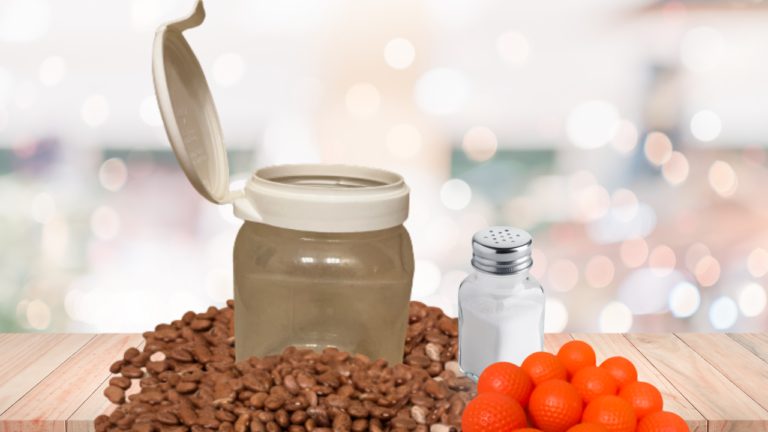Do Your Students Frequently Run Out of Time???
Ever hear students complain, “I didn’t have time to do my homework!” or “I was too busy to clean my room!”? The truth is, we all have the same 24 hours in a day—it’s how we prioritize our time that makes the difference.
This hands-on STEAM challenge will help students discover a simple but powerful lesson: when we take care of our HAVE TOs first, there’s still plenty of time for WANT TOs—but if we do it the other way around, things get messy fast!
⏳ Time is ticking! What are YOU waiting for? Gather some supplies, and let’s get started!
Grade Level: Upper Elementary – Middle School
Duration: 30-45 minutes
Materials (per group):
1 48 oz. clear plastic jar with snapping lid
13 plastic golf balls (or similar-sized balls)
2 cup of dried beans
1 cup of salt (optional, for demonstration)

Learning Objectives
By the end of this lesson, students will:
- Experiment with different ways to fit items into a limited space, applying problem-solving skills.
- Discover the importance of prioritization through a hands-on STEM challenge.
- Recognize the difference between “have to” and “want to” tasks in daily life.
- Identify and reduce time-wasting behaviors.
SEL Competencies (CASEL)
- Self-Management: Demonstrating self-discipline by prioritizing responsibilities.
- Self-Awareness: Recognizing how choices impact daily schedules and emotional well-being.
- Responsible Decision-Making: Understanding how prioritization leads to better outcomes.
ASCA Mindsets & Behaviors
-
M6: Ability to balance school, home, and community activities.
- M7: Development of self-discipline and self-control.
- B-SMS 1: Assume responsibility for behaviors and decisions.
- B-SMS 6: Overcome barriers to learning.
- B-LS 3: Use time-management and organizational skills effectively.
Lesson Procedure
Engage (10-12 minutes) – STEAM Challenge: Can You Fit Everything In?
- Group Challenge:
- Divide students into small groups (3-4 students each).
- Give each group a jar and a container of 13 golf balls, and 2 cups of dried beans.
- Challenge: Fit everything into the jar so that the lid snaps shut.
- Rule: They cannot force the lid down—it must close naturally.
- Let Them Struggle (Discovery-Based Learning):
- Observe as students experiment.
- Most will start by pouring in the beans first, then struggle to fit the golf balls.
- Encourage them to test different methods without giving them the answer.
- Debrief:
- Ask groups to share their strategies.
- If any group successfully fits everything, have them explain how.
- If not, demonstrate the solution:
- Put the golf balls in first (HAVE TOs), then pour the beans around them (WANT TOs).
- Everything fits!
Explore (5 minutes) – The Big Reveal: What Does This Mean?
- Explain that the jar represents one day’s worth of time.
- The golf balls represent HAVE TOs (eating, sleeping, schoolwork, chores).
- The beans represent WANT TOs (screen time, playing, chatting with friends).
- If we prioritize HAVE TOs first, there’s still plenty of time for WANT TOs.
- If we start with WANT TOs, there’s often no room left for HAVE TOs.
Explain (5 minutes) – The Time Waster Effect (Optional: Salt Demonstration)
- Introduce salt as “time wasters” (whining, complaining, arguing).
- Pour salt into the jar after the beans and balls to show how it fills the gaps and takes up space.
- Discuss how time wasters steal time from both HAVE TOs and WANT TOs.
Discussion Questions:
- What are some time-wasting habits you notice in yourself?
- How can we avoid wasting time?
Elaborate (10 minutes) – Real-World Application
- Partner Activity: Create a daily schedule prioritizing HAVE TOs first.
- Personal Reflection:
- What’s one HAVE TO you will complete first this week?
- What’s one WANT TO you’ll earn by prioritizing well?
- Class Brainstorm:
- List strategies to avoid time wasters.
- Set a class goal to practice prioritization.
Evaluate (5 minutes) – Exit Reflection
- What did you learn from the STEAM challenge?
- How can prioritizing help you feel more in control of your time?
- What will you do differently after today’s lesson?
Watch this Lesson on YouTube
Extension Activity: Visual Reflection & Writing Prompt
Use photos of the jar filled in different ways as a visual reminder of time management choices. These images can also serve as writing prompts for students to reflect on their own habits.
Example Scenarios & Meanings:
📸 All beans at the bottom – Represents excessive screen time or distractions taking up the entire day, leaving no room for homework, sleep, or responsibilities.
📸 Golf balls at the bottom with beans filling spaces – Demonstrates effective prioritization—completing HAVE TOs first and still having time for WANT TOs.
📸 Salt overflowing the jar – Shows how time-wasters (whining, procrastinating, arguing) consume valuable time, making it difficult to fit in both HAVE TOs and WANT TOs.
Writing Prompt Ideas:
Describe the photo. What does this jar tell you about how someone is managing their time?
Make it personal. Have you ever had a day like this? What could you do differently next time?
Problem-Solving Challenge. If a friend was struggling with prioritizing, what advice would you give them?
Encourage students to write, discuss, or even create their own photo examples to represent different time management habits!
Preparation Note for Educators:
Before leading the lesson, test the materials to determine the exact amount of beans needed for your specific jar. The number of golf balls may vary based on jar size. I purchased 48 oz. plastic jars at Dollar Tree for this lesson.
Steps to Prepare:
- Place the golf balls into the jar first and count how many fit comfortably. (My jars each fit 13 golf balls.)
- Slowly pour in the beans around the golf balls, shaking the jar gently to help them settle. (Approximately 2 cups of dried pinto beans for each of my jars.)
- Measure the total amount of beans needed to fill the jar while ensuring the lid closes properly.
- The amount of beans will depend on the jar size and shape.
- Record your final amounts so that students have the right materials for the challenge

